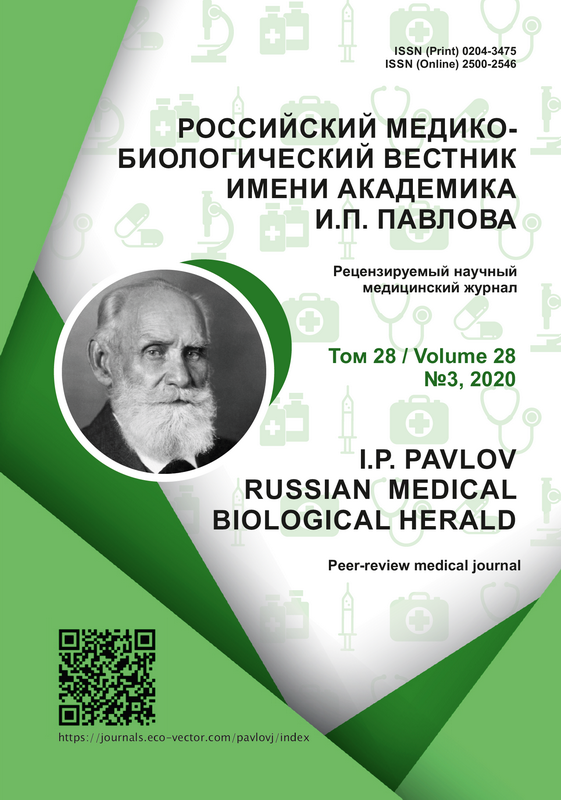Прогностическая роль показателей динамической капнографии в интегральной оценке параметров дыхательной системы при 6-минутном шаговом тесте у пациентов с хронической сердечной недостаточностью
- Авторы: Агеева К.А.1, Филиппов Е.В.1
-
Учреждения:
- ФГБОУ ВО Рязанский государственный медицинский университет им. акад. И.П. Павлова Минздрава России
- Выпуск: Том 28, № 3 (2020)
- Страницы: 290-299
- Раздел: Оригинальные исследования
- Статья получена: 25.05.2020
- Статья одобрена: 04.08.2020
- Статья опубликована: 19.10.2020
- URL: https://journals.eco-vector.com/pavlovj/article/view/34163
- DOI: https://doi.org/10.23888/PAVLOVJ2020283290-299
- ID: 34163
Цитировать
Аннотация
Цель. Изучить прогностическую ценность показателей динамической капнографии в комплексной оценке параметров дыхательной системы при выполнении 6-минутного шагового теста у больных хронической сердечной недостаточностью (ХСН).
Материалы и методы. Обследовано 73 пациента: исследуемую группу составили 48 больных ХСН IIA или IIБ стадии (средний возраст 57,9±4,6 лет, 23 мужчины), группу контроля – 25 практически здоровых добровольца (средний возраст 47,6±3,5 лет, 9 мужчин). Пациентам проводилось комплексное определение параметров дыхательной системы: клиническое шкалирование до и после 6-минутного шагового теста (6МШТ), инструментальные методы, включающие спирометрию, капнографию и пульсоксиметрию до, во время и после выполнения физической нагрузки. Анализ выживаемости проведен на основании динамического наблюдения за пациентами в течение 5 лет (60 месяцев).
Результаты. При проведении анализа параметров одышки в покое выявлено, что все показатели были выше в группе пациентов с ХСН (р<0,05). Расстояние, пройденное пациентами с ХСН за 6 минут, составило 488,23±90,84 м, что значительно меньше, чем в группе контроля (815,60±53,89 м, р=0,009). Одышка как причина остановки/замедления темпа ходьбы при проведении 6МШТ также чаще регистрировалась у больных с ХСН (93,8±3,0% и 48,0±5,1%, р=0,049). Кроме того, при выполнении 6МШТ пациенты отмечали: слабость в ногах (50,1±5,0% в группе ХСН и 40,0±5,0% в группе контроля, р=0,014), сердцебиение (29,0±4,6% и 20,0±4,1% соответственно, р=0,004). Усугубление показателей одышки во время выполнения 6МШТ у пациентов с ХСН было более выражено, чем в группе контроля (р<0,01). В группе ХСН при выполнении 6МШТ выявлен гипокапнический тип вентиляции, при анализе графиков тренда РЕТСО2 – волнообразное повышение показателей, так называемое «периодическое дыхание» (ПД). Тренд СО2 в группе ХСН зарегистрирован в 58,3±1,0% случаев (различие с группой контроля с р=0,046), тренд частоты сердечных сокращений – в 18,8±0,3% (р=0,027). С помощью регрессионного анализа пропорциональных рисков Кокса летальности у больных ХСН выявлено прогностическое значение комплексной модели, включившей следующие параметры пациента: индекс массы тела (р=0,005), конечный диастолический размер левого желудочка (р=0,034), конечный систолический размер левого желудочка (р=0,002), фракция выброса левого желудочка (р=0,041), дистанция 6МШТ (р=0,004), десатурация (р=0,009), а также наличие признаков ПД во время 6МШТ (р=0,005). Статистическая значимость коэффициентов модели с р<0,0001.
Выводы. Динамическая капнография и пульсоксиметрия позволяет выявить признаки ПД у пациентов с ХСН во время выполнения 6МШТ, что может углубить комплексную оценку параметров кардио-респираторной системы у больных ХСН с целью определения толерантности к физической нагрузке, а также эффективности проводимого лечения. При комплексной оценке выживаемости пациентов с ХСН выявлено прогностическое значение следующих параметров пациента: индекс массы тела, конечный диастолический размер левого желудочка, конечный систолический размер левого желудочка, фракция выброса левого желудочка, дистанция 6МШТ, десатурация, ПД во время 6МШТ.
Полный текст
Об авторах
Кира Александровна Агеева
ФГБОУ ВО Рязанский государственный медицинский университет им. акад. И.П. Павлова Минздрава России
Email: ageeva3010k@gmail.com
ORCID iD: 0000-0001-8537-7437
SPIN-код: 8756-3153
ResearcherId: M-9092-2016
ассистент кафедры инфекционных болезней
Россия, РязаньЕвгений Владимирович Филиппов
ФГБОУ ВО Рязанский государственный медицинский университет им. акад. И.П. Павлова Минздрава России
Автор, ответственный за переписку.
Email: dr.philippov@gmail.com
ORCID iD: 0000-0002-7688-7176
SPIN-код: 2809-2781
ResearcherId: O-1490-2016
д.м.н., доцент, зав. кафедрой поликлинической терапии и профилактической медицины
Россия, РязаньСписок литературы
- Федеральная служба государственной статистики. Доступно по: https://www.gks.ru/folder/13721. Ссылка активна на 20 мая 2020.
- Мареев В.Ю., Фомин И.В., Агеев Ф.Т., и др. Клинические рекомендации ОССН – РКО – РНМОТ. Сердечная недостаточность: хроническая (ХСН) и острая декомпенсированная (ОДСН). Диагностика, профилактика и лечение // Кардиология. 2018. Т. 58, №S6. C. 8-158. doi: 10.18087/cardio.2475
- Ponikowski P., Voors A.A., Anker S.D., et al. Guidelines for the diagnosis and treatment of acute and chronic heart failure: The Task Force for the diagnosis and treatment of acute and chronic heart failure of the European Society of Cardiology (ESC) developed with the special contribution of the Heart Failure Association (HFA) of the ESC // European Heart Journal. 2016. Vol. 37, №27. P. 2129-2200. doi: 10.1093/eurheartj/ehw128
- Общие вопросы методики исследования и критерии оценки показателей дыхания. В кн.: Шик Л.Л., Канаев Н.Н., ред. Руководство по клинической физиологии дыхания. Л.: Медицина; 1980.
- Тетенев Ф.Ф. Особенности механики дыхания при различных формах патологии бронхолёгочной системы. Обоснование гипотезы о механической активности лёгких. Дис. … д-ра мед. наук. Томск; 1976.
- Абросимов В.Н., ред. Одышка и ассоциированные синдромы. Рязань: РязГМУ; 2018. Вып. 6.
- Абросимов В.Н., Алексеева Е.А., Пономарева И.Б., и др. Применение методов клинического шкалирования и вопросников в пульмонологии. Рязань: РИО РязГМУ; 2011.
- Бяловский Ю.Ю. Реципрокные реакции организма на разные величины увеличенного сопротивления дыханию // Российский медико-биоло-гический вестник имени академика И.П. Павлова. 2016. Т. 24, №1. С. 19-24.
- Абросимов В.Н., Перегудова Н.Н., Косяков А.В. Оценка функциональных показателей дыхательной системы у пациентов с хронической обструктивной болезнью легких при проведении 6-минутного шагового теста // Наука молодых (Eruditio Juvenium). 2019. Т. 7, №3. С. 323-331. doi: 10.23888/HMJ201973323-331
- Низов А.А., Ермачкова А.Н., Абросимов В.Н., и др. Ведение больных ХОБЛ: роль оценки заболевания в реальной клинической практике // Наука молодых (Eruditio Juvenium). 2018. Т. 6, №3. С. 429-438. doi: 10.23888/HMJ201863429-438
- Graham B.L., Steenbruggen I., Miller M.R., et al. Standardization of Spirometry 2019 Update. An Official American Thoracic Society and European Respiratory Society Technical Statement // American Journal of Respiratory and Critical Care Medicine. 2019. Vol. 200, №8. P. e70-e88. doi:10.1164/ rccm.201908-1590st
- Методические рекомендации по использованию метода спирометрии. Доступно: https://spulmo.ru/ obrazovatelnye-resursy/federalnye-klinicheskie-rekomendatsii/. Ссылка активна на 20 мая 2020.
- Воробьева З.В. Функция внешнего дыхания при хронической обструктивной болезни легких в стадии 0 (ноль) // Функциональная диагностика. 2005. №2. С. 29-32.
- Agostoni P., Corrà U., Emdin M. Periodic Breathing during Incremental Exercise // Annals of the American Thoracic Society. 2017. Vol. 14, №S1. P. S116-S122. doi: 10.1513/AnnalsATS.201701-003FR
- Baruch V., Amin A., Christle J.W., et al. A method for determining exercise oscillatory ventilation in Heart Failure: prognostic value and practical implications. International Journal of Cardiology. 2017. Vol. 249. P. 287-291. doi: 10.1016/j.ijcard.2017.09.028
Дополнительные файлы












